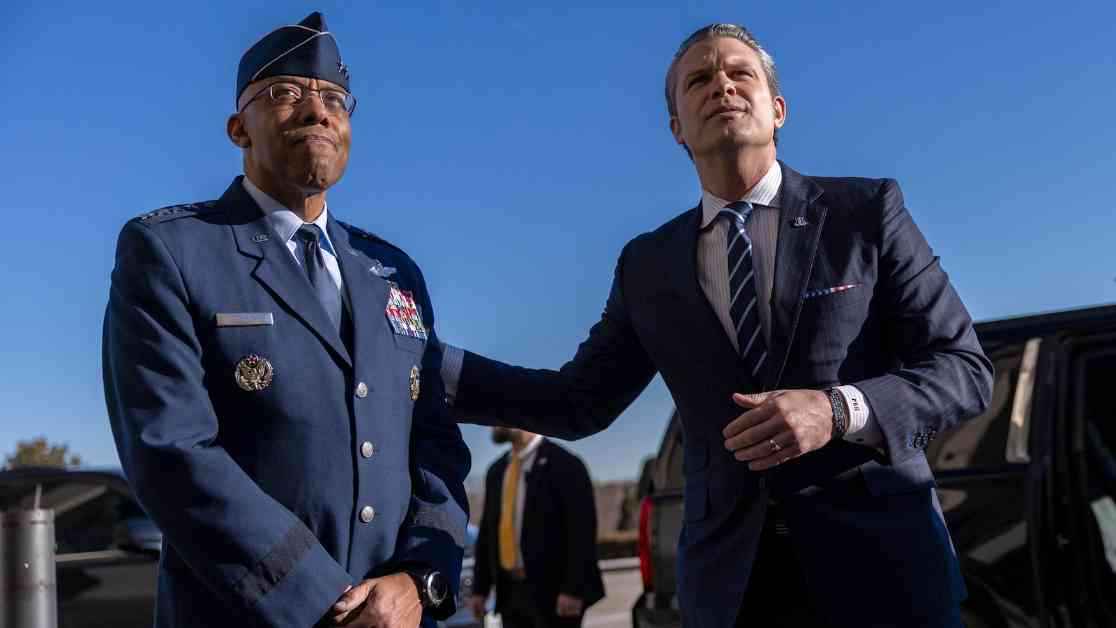President Donald Trump has made waves with his recent move to dismiss Gen. Charles “CQ” Brown Jr., chairman of the Joint Chiefs of Staff, and Adm. Lisa Franchetti, the Navy’s top admiral. This unprecedented action marks the first time two members of the Joint Chiefs of Staff have been removed from their senior military roles. The sudden shake-up in top military leadership has raised eyebrows and sparked debate across the nation.
Gen. Charles “CQ” Brown Jr. and Adm. Lisa Franchetti Dismissed
As a retired military officer, Lt. Gen. Dan Caine has been tapped to fill the void left by the departure of Gen. Brown. Caine, with a distinguished career spanning 34 years in the Air Force, comes highly qualified to assume the role of the president’s senior military adviser and the nation’s top military officer. His nomination will need to be confirmed by the Senate before officially stepping into his new position.
President Trump took to his Truth Social account to express gratitude to Gen. Brown for his more than 40 years of service to the country, acknowledging his leadership and dedication. With Lt. Gen. Caine set to take on the mantle of chairman of the Joint Chiefs of Staff, a new chapter begins in the nation’s military leadership.
Implications of the Dismissals
Gen. Brown, who became the president’s top military adviser in October 2023, was expected to complete a four-year term that would have ended in September 2027. He was only the second African American to hold this crucial role, while Adm. Franchetti was the first woman to serve as the Navy’s top admiral. The chairman’s position is designed to be apolitical, ensuring stability even during presidential transitions.
Under President Trump’s authority, generals and senior officers may be removed from their posts, potentially reshaping the top echelons of the military hierarchy. The recent dismissals of Gen. Brown and Adm. Franchetti have led to speculation and concerns about the political motivations behind these decisions. The impact of these changes on military operations and national security remains to be seen.
Reactions and Controversies
The removal of two senior military officers has generated mixed reactions from various quarters. Defense Secretary Pete Hegseth called both Gen. Brown and Adm. Franchetti to notify them of their dismissals, setting off a chain of events that included the nomination of new appointees to key positions. The reshuffling of leadership in the armed forces has prompted statements of support, disappointment, and skepticism from different lawmakers and experts.
Retired Gen. George Casey, a former Army Chief of Staff, raised concerns about the implications of dismissing officers based on political considerations rather than merit. The delicate balance of civilian control over the military is at the heart of the matter, with questions raised about the long-standing principle of nonpartisanship in military appointments. The fallout from these decisions could have far-reaching consequences for national security and civil-military relations.
As the nation grapples with the aftermath of these abrupt changes in military leadership, the spotlight remains on President Trump’s decision-making and the future direction of the armed forces. The appointment of Lt. Gen. Caine as the new chairman of the Joint Chiefs of Staff heralds a new era in the top brass of the military, with implications that extend beyond the confines of the Pentagon. The coming days will reveal the extent of the impact of these dismissals and the path forward for the U.S. military.


